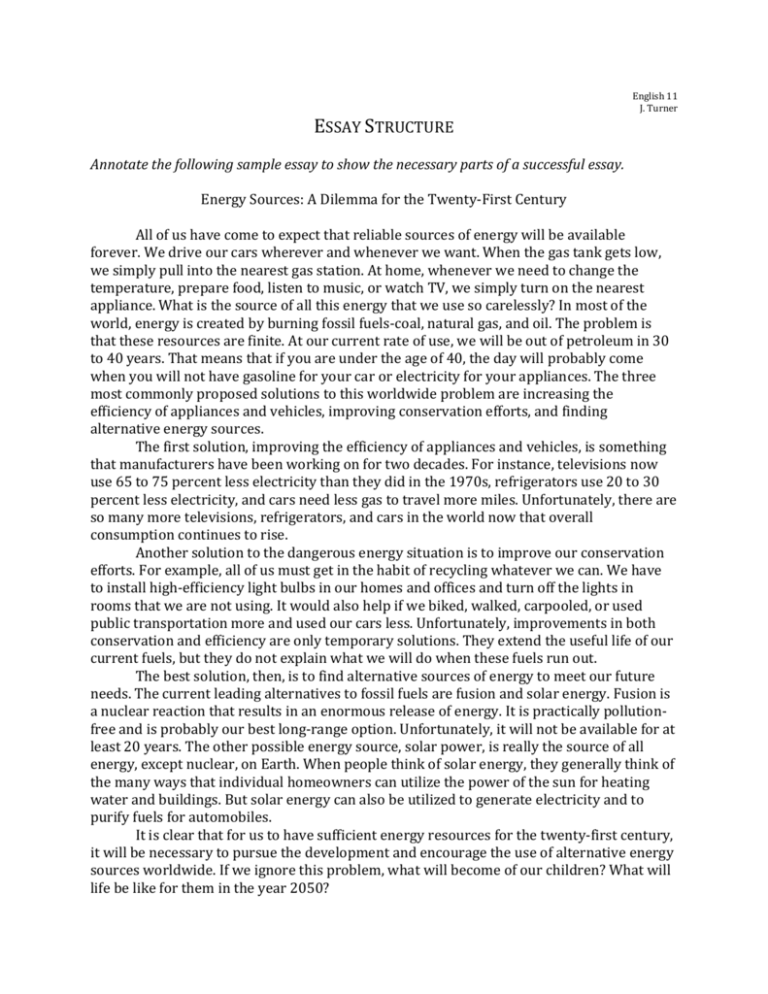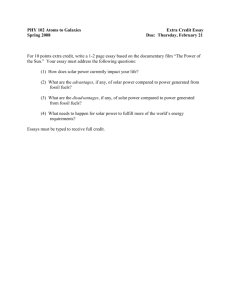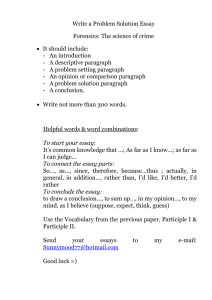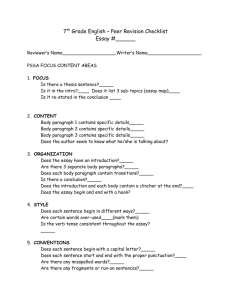the structure of a five paragraph essay
advertisement

ESSAY STRUCTURE English 11 J. Turner Annotate the following sample essay to show the necessary parts of a successful essay. Energy Sources: A Dilemma for the Twenty-First Century All of us have come to expect that reliable sources of energy will be available forever. We drive our cars wherever and whenever we want. When the gas tank gets low, we simply pull into the nearest gas station. At home, whenever we need to change the temperature, prepare food, listen to music, or watch TV, we simply turn on the nearest appliance. What is the source of all this energy that we use so carelessly? In most of the world, energy is created by burning fossil fuels-coal, natural gas, and oil. The problem is that these resources are finite. At our current rate of use, we will be out of petroleum in 30 to 40 years. That means that if you are under the age of 40, the day will probably come when you will not have gasoline for your car or electricity for your appliances. The three most commonly proposed solutions to this worldwide problem are increasing the efficiency of appliances and vehicles, improving conservation efforts, and finding alternative energy sources. The first solution, improving the efficiency of appliances and vehicles, is something that manufacturers have been working on for two decades. For instance, televisions now use 65 to 75 percent less electricity than they did in the 1970s, refrigerators use 20 to 30 percent less electricity, and cars need less gas to travel more miles. Unfortunately, there are so many more televisions, refrigerators, and cars in the world now that overall consumption continues to rise. Another solution to the dangerous energy situation is to improve our conservation efforts. For example, all of us must get in the habit of recycling whatever we can. We have to install high-efficiency light bulbs in our homes and offices and turn off the lights in rooms that we are not using. It would also help if we biked, walked, carpooled, or used public transportation more and used our cars less. Unfortunately, improvements in both conservation and efficiency are only temporary solutions. They extend the useful life of our current fuels, but they do not explain what we will do when these fuels run out. The best solution, then, is to find alternative sources of energy to meet our future needs. The current leading alternatives to fossil fuels are fusion and solar energy. Fusion is a nuclear reaction that results in an enormous release of energy. It is practically pollutionfree and is probably our best long-range option. Unfortunately, it will not be available for at least 20 years. The other possible energy source, solar power, is really the source of all energy, except nuclear, on Earth. When people think of solar energy, they generally think of the many ways that individual homeowners can utilize the power of the sun for heating water and buildings. But solar energy can also be utilized to generate electricity and to purify fuels for automobiles. It is clear that for us to have sufficient energy resources for the twenty-first century, it will be necessary to pursue the development and encourage the use of alternative energy sources worldwide. If we ignore this problem, what will become of our children? What will life be like for them in the year 2050? IMAGE EXPLICATION English 11 J. Turner Find or create an image about the text. It should fall into one of these categories. - A character list - A cover - A scene illustration - A character study - An image that alludes to the novel or key ideas from it - A film still - An adaptation Do not choose - A map - A poster - A chart Explain the elements of the image with reference to the important themes and symbolism of the novel. Use the vocabulary you have learned previously. What techniques and choices has the illustrator made in order to encode information visually? What elements of style, tone, or specific choices do you disagree with, if any. Create an outline for a five paragraph essay including point form details about the following: - - - - Introduction o Hook o Context o Thesis statement First body paragraph o Topic sentence o Detailed explication and evidence Second body paragraph o Transition o Topic sentence o Detailed explication and evidence Third body paragraph o Transition o Topic sentence o Detailed explication and evidence Conclusion o Restatement of thesis o Impact statement










